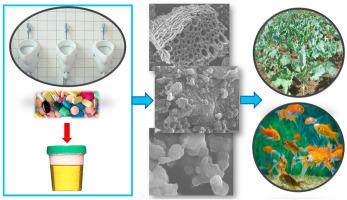Environmental Pollution ( IF 7.6 ) Pub Date : 2020-09-18 , DOI: 10.1016/j.envpol.2020.115683 Sammani Ramanayaka , Manish Kumar , Thusitha Etampawala , Meththika Vithanage

|
Macro (BC), colloidal (CBC) and nanobiochar (NBC) were examined for the particle size effect for adsorptive removal of oxytetracycline (OTC) and co-occurring nutrients, which are present in synthetic hydrolyzed human urine. The surface morphologies and functionality of biochars were characterized using Scanning Electron Microscopy (SEM), Brunauer-Emmett-Teller (BET) specific surface area and Fourier Transform Infra-Red (FTIR) Spectroscopy. Experiments for the removal of OTC were performed at the natural pH (pH 9.0) of hydrolyzed human urine using solid-solutions of 3 types of chars (1 g/L) with a contact time of 5 h, at initial OTC concentration of 50 mg/L where isotherm experiments were investigated with OTC concentrations from 25-1000 mg/L. The highest maximum adsorption capacity of 136.7 mg/g was reported for CBC, while BC reported slightly low value (129.34 mg/g). Interestingly, NBC demonstrated a two-step adsorption process with two adsorption capacities (16.9 and 113.2 mg/g). Colloidal biochar depicted the highest adsorption for NH4+, PO43-, and SO42- nutrients. All 3 types of chars showed strong retention with a poor desorption (6% in average) of OTC in synthetic hydrolyzed urine medium. CBC and NBC demonstrated both physisorption and chemisorption, whereas the OTC removal by BC was solely via physisorption. Nevertheless, CBC biochar demonstrated the best performance in adsorptive removal of OTC and nutrients in hydrolyzed human urine and its capability towards wastewater treatment. As the removal of nutrients were low, the treated urine can possibly be used as a safe fertilizer.
中文翻译:

宏观,胶体和纳米生物炭去除合成水解人类尿液中的土霉素。
检查Macro(BC),胶体(CBC)和nanobiochar(NBC)的颗粒大小效应,以吸附去除合成水解人尿中存在的土霉素(OTC)和共生养分。使用扫描电子显微镜(SEM),Brunauer-Emmett-Teller(BET)比表面积和傅里叶变换红外(FTIR)光谱对生物炭的表面形态和功能进行了表征。OTC的初始去除浓度为50 mg,在3种类型的炭(1 g / L)的固溶体中,接触时间为5 h,在水解后的人类尿液的自然pH(pH 9.0)下进行OTC去除实验。 / L,其中等温线实验的OTC浓度为25-1000 mg / L。据报道,CBC的最高最大吸附容量为136.7 mg / g,而卑诗省报告值略低(129.34 mg / g)。有趣的是,NBC展示了具有两个吸附容量(16.9和113.2 mg / g)的两步吸附过程。胶体生物炭对NH的吸附最高4 +,PO 4 3-和SO 4 2-营养素。在合成的水解尿液中,所有三种类型的炭都显示出较强的保留能力,OTC的解吸性很差(平均6%)。CBC和NBC均表现出物理吸附和化学吸附,而BC去除OTC仅通过物理吸附。尽管如此,CBC生物炭在吸附去除水解的人类尿液中的OTC和养分方面表现出最好的性能,并且具有废水处理能力。由于去除的养分很少,因此处理后的尿液可以用作安全肥料。











































 京公网安备 11010802027423号
京公网安备 11010802027423号